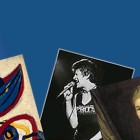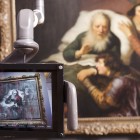-
The most appealing results of the research done in the Research Agenda 2008-2012 set in the spotlights.
-
Showcase Mill-X-Molen
-
Showcase The Victory Boogie Woogie unwrapped
-
Showcase Govert Flinck in AR
-
Showcase Does it work or does it not?
-
Showcase Vincent van Gogh at work
-
Showcase Charlene at risk?
-
Showcase DimCon, the digital red carpet
-
Showcase Apps and websites: audience attractors?Reading modeshare
Apps and websites: audience attractors?
A guide for museums
An app can be an effective public guide that supplies museum visitors with extra information and a richer experience. But apps are also a means to attract the public. That is certainly not only restricted to the physical public.
For with an app you can provide access to the collection even for people who cannot come to the museum. Even so, to develop an app oneself is too expensive and labour intensive for many museums. Collaboration is the key. This way you can significantly reduce costs and above all achieve a greater reach.
MuseumApp
The MuseumApp is such a collaboration experiment. It was launched in 2011 by Waag Society/7Scenes and the Amsterdam Museum. The aim of this pilot project is to collaborate with ten Amsterdam museums in developing one application that all Dutch museums can use to independently develop their own multimedia tour. The RCE participated as a research partner in the pilot study to determine the extent to which such an app can effectively generate new museum visitors.
Feasibility
A good app with solid content is definitely not something that a cultural institution carries out in an afternoon. But that was not the object of this research. Thanks to the user-friendly MuseumApp software, the Geheim Museumplein [Secret Museum Square] app was put together quite quickly. So far, so good. The problem was mainly with the follow up. The RCE does not need to be a 'crowd puller' and therefore cannot be compared to a museum in this context. Thus it quickly became apparent that an app can only be viable when much time and effort is put into its promotion. No opportunity should go by without promoting your app both through analogue channels - folders on the counter with QR code - and virtual such as social media, your own and other websites. If not done (as in the case of the RCE), then the purchase of the product is proportionally affected, i.e., virtually zero in this case.
Guide
In a parallel project RCE researchers set up a guide for measuring and increasing the effectiveness of apps (and websites) of museum institutions: the Guide to effective public research. Starting point: you have an app or website developed with the aim to attract more physical visitors to your museum or exhibition. How do you know whether the chosen means works? And what are the existing opportunities to enhance the effectiveness?
The section on tips for apps was 'fed' by the experiences with the MuseumApp. For websites this largely achieved through another case: a public survey on the Virtual Armando Museum.
App-lessons
Many tips for a more effective use of apps emerged from the findings of other museum participants in the MuseumApp pilot project. Optimisation begins with content. Thus one starting point of the MuseumApp is that users should be able to join the route at any point. On the other hand a public test in Amsterdam showed that users preferred to be guided through the narrative along a fixed route. So you have to attempt to unite such conflicts of interest in the content. In addition, the test respondents had a need of route directions because not all knew the location well. Such information would mean less space on a small screen for a meaningful narrative.
Content and marketing
Concerning target groups, apps currently appeal mostly to young people. This should be taken into account both with the content, but also in marketing the app. To simply place it in the App store fails: the app cannot be found there if it is not attracting attention through relevant (analogue and digital) channels. To increase the reach of the app it is advisable to also provide the content in English at least. And so on ...

Check
Once the checklist with tips for content 'findability' is checked off, the app can be deployed for the ultimate goal: to attract more visitors to the museum. That requires making connections between app and museum visits, for example, by launching the app around the opening of a new exhibition, an expansion of the collection or an event at the museum. Or perhaps by allowing the user to collect points along the way, which add up to a discount on an admission ticket.
Website-wise
The list of recommendations for increasing the effectiveness of websites in the guide is shorter than for app's. Websites are more common in the cultural sector and there is more available information about optimisation. Tips for app and websites partially overlap but there are also significant differences. For example, a website needs to serve diverse target groups simultaneously while an app does a better job if it is aimed at one single target group. Furthermore, users access websites with a variety of media, including iPads and smartphones, which has implications for navigation and the frequently used plug-in Flash does not work on Apple devices.
However if the aim is to draw public to the museum through the website, then the motto is exactly the same as for app's: create as many links as possible between the virtual and the physical museum.
Measuring effectiveness
Public research is required to find out whether your developed app or website actually has this desired effect. There really is no need to hire a pricey PR firm. As a museum, you can learn a great deal by conducting low threshold research yourself. In the case of an app or website the most logical form is a survey presented to your public through the app or website in question.

Virtual museum
The RCE conducted a public survey of users of the Virtual Armando Museum. The Guide to effective public research provided a model approach for this type of public survey.
The public response to the pilot survey was initially disappointing. First a good book on Armando about was raffled among participants but that did not yield much. A more personal appeal through Facebook and LinkedIn was more successful. A total of 293 people participated in the survey on www.armandomuseum.nl.Questions
Questions about the Virtual Armando Museum were broadly grouped under the following headings:
- Familiarity with the website;
- Reason for visiting the website;
- Satisfaction with the website;
- Physical visit (are you considering visiting the physical museum following your website visit?)
- Background variables (gender, age, type of household, education).
Outcomes
One of the outcomes was that many people 'arrived' at the Virtual Armando Museum by entering keywords in search engines. The corresponding advice in the guide was: make sure that your website can be found by search engines (through SEO = search engine optimization). The request for concrete improvements for the website turned out to be a source of useful tips. Many respondents found that the presentation (in floating cubes) of information on elements of Armando's work too cluttered. Some suggested useful additions such as a walk-through or an activity agenda, which could certainly be an effective link between website and the physical museum when it opens in 2014.
'Learn from your visitors'. This may seem glaringly obvious, but it is not always self-evident for many museums. And with that advice we have come full circle. The only products you can effectively use as crowd pullers are those that you have regularly tested for their effectiveness on your public.

MuseumApp
The MuseumApp is an app format for the heritage sector with which cultural heritage institutions can outline routes in their surroundings. The app is designed for the outdoors, but can also be utilised indoors for exhibitions. The app also includes interactive (game-like) elements. For instance, during the route users can add interesting information and upload photos.
Virtual Armando Museum
Since the closure of the Armando Museum in late 2011 the Armando Collection has been managed by the MOA (Museum Oud Amelisweerd) that will be opening its doors in 2014. A large part of the artist's oeuvre is already on display in the Virtual Armando Museum through the Internet.
Publications
Lensink, H., Toepassingen voor Mobiele Media: een onderzoek naar de effectiviteit van Virtuele Toegankelijkheid voor Musea, RCE (Amersfoort), 2013.
Stroeker, N., Handreiking effectief publieksonderzoek. Inzet van websites en apps bij musea, Research voor beleid / Panteia (Zoetermeer), 2013.
Links
Website MuseumApp
Website Virtueel Armando Museum
Website Waag Society / 7Scenes
Projectleider
Hester Lensink
Teamleden
Hanneke van der Beek, Hans Schraven, Maartje Vos-Swinkels (AkinaArt); Rosa Posthoorn, Kaija de Valk en Charlotte Gentenaar (Reinwardt Academie)
Partner
Waag Society/7Scenes, Amsterdam
-
Showcase Colours from yesteryears
-
Showcase Slippery when wet!
-
Showcase A new (old) window





